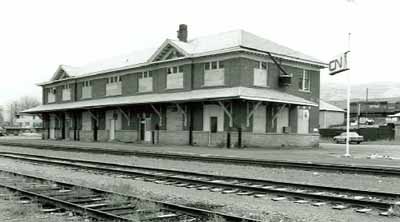Canadian National Railway Station
Heritage Railway Station of Canada
Kamloops, British Columbia

General view of the place
(© Harold Kalman, 1991.)
Address :
500 Lorne Street, Kamloops, British Columbia
Recognition Statute:
Heritage Railway Stations Protection Act (R.S.C., 1985, c. 52 (4th Supp.))
Designation Date:
1992-06-04
Dates:
-
1926 to 1927
(Construction)
Event, Person, Organization:
-
Canadian National Railways
(Organization)
-
CNR Architectural Division
(Architect)
-
Johnston and Co.
(Builder)
Research Report Number:
RS-123
Description of Historic Place
The Canadian National Railway (CNR) station at Kamloops, British Columbia is a substantial two storey station of restrained modern classical design. Located at 500 Lorne St., it is one of the few remaining buildings in what was once an extensive CNR divisional point complex.
Heritage Value
The CNR station at Kamloops, British Columbia has been designated a heritage railway station for its historical, architectural and environmental significance.
The Kamloops CNR station was built in 1926-27 by the local firm of Johnston and Company to designs prepared by the CNR Architectural Division in Winnipeg. It is a handsome masonry building that portrays an innovative synthesis of traditional picturesque station design and more contemporary neoclassical elements. It was one of the earliest stations in Canada to reflect the restrained classicism that subsequently became common for both railway and non-railway public architecture.
This station’s sophistication reflects its importance as a CNR symbol. It was built on the main line the CNR developed in western Canada shortly after the company itself was created from an amalgamation of earlier railway lines. Since CNR constructed new facilities only when they were required to supplement existing ones, creation of a substantial divisional point at Kamloops was a major activity. The CNR’s intention was to undercut the monopoly Canadian Pacific Railway had held in the Kamloops area for over 30 years. This goal was expedited by subsequent construction of a branch line to Kelowna through Kamloops. As a result, the Kamloops station served as a terminal for both main and branch line service until it was converted to its present use as railway offices. Today, it sits in a scenic though isolated setting within a larger railway landscape that has retained its topographical features but few of its early buildings.
The heritage character of the Kamloops station resides in its overall form, materials and detailing, and in its expression of restrained classicism.
Source:
· Heritage Character Statement, Kamploops Canadian National Railways Station, January 1993. Heritage Assessment Report RSR-123, 1991.
Character-Defining Elements
Character-defining elements of the Kamloops Canadian National Railway Station include:
the rectangular footprint, 2 storey cube-like massing, and medium-hipped roof of the station broken by parallel off-set gables, its simple but symmetrical proportions, as underlined by the placement of projecting bays and the rhythm of window and door openings, its horizontal definition as emphasized by the lines of the roof ridge, the row of dentils at the cornice, the long low canopy, and the narrow stone water table above the granite base, the smooth aesthetic integration of such railway features such as its projecting telegrapher’s bay and platform canopy, its classically inspired details: pediment-like gables, pedimented town-side entry bay, strong cornice line with dentils, the varying textures of its original materials: brick walls and decorative features, rock-faced granite base, dentil supports and voussoirs, metal roof, wooden doors and trim, paired multi-paned wood sash windows, the station’s platform frame construction technology, all original fabric inside the station, in particular surviving plaster walls, oak and mahogany trim, maple floors on the first floor and imitation oak trim and glass partitions on the upper floor, continued legibility of the station’s original functional subdivisions including the retention of original partitions, legibility of the station’s original spatial volumes, including its original ceiling heights, the continuity of longstanding circulation patterns, the overall integrity of the building’s form, plan, material, and detail.